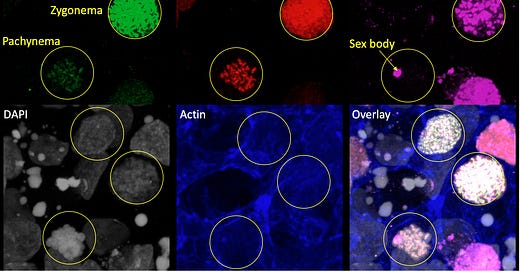I’m happy to announce that the meiosis project preprint is now out! You can read it on bioRxiv: https://www.biorxiv.org/content/10.1101/2024.05.31.596483v1
Here’s what we did:
Identified conditions that can initiate meiosis in human iPSCs
The protocol works reliably in male and female hiPSCs, and takes 13-15 days to reach pachynema
Characterized stages of meiosis in the cells
Characterized the gene expression in the cells over time
Interestingly, we are activating a lot of oogonia-related genes, but skipping over the primordial germ cell stage
Here’s what we haven’t done (yet):
Produced late-stage meiotic cells (pachytene and later) with high efficiency. We do see a few pachytene cells, but most cells don’t make it that far.
Fully characterized the patterns of chromosome recombination.
Restored the DNA methylation (after we erased it) in order to establish sex-specific imprinting.
Generated haploid human cell lines that can proliferate in culture.
Even though there’s still a lot more work to be done, I’m very excited about the progress we’ve made. As far as I know, no other protocols have made it past leptonema. (The Saitou lab just published a method of growing large numbers of human oogonia, which is very cool, but they don’t do meiosis.) I don’t think it’s an understatement to say that this is a new state of the art for the field of human in vitro gametogenesis.
I’ll end with a pretty picture:




Extremely exciting news for folks interested in vastly more powerful gengineering / embryo selection, thanks for sharing.
Fascinating work. In your research, to what degree is insight from non-human gametogenesis models incorporated? What models are used?